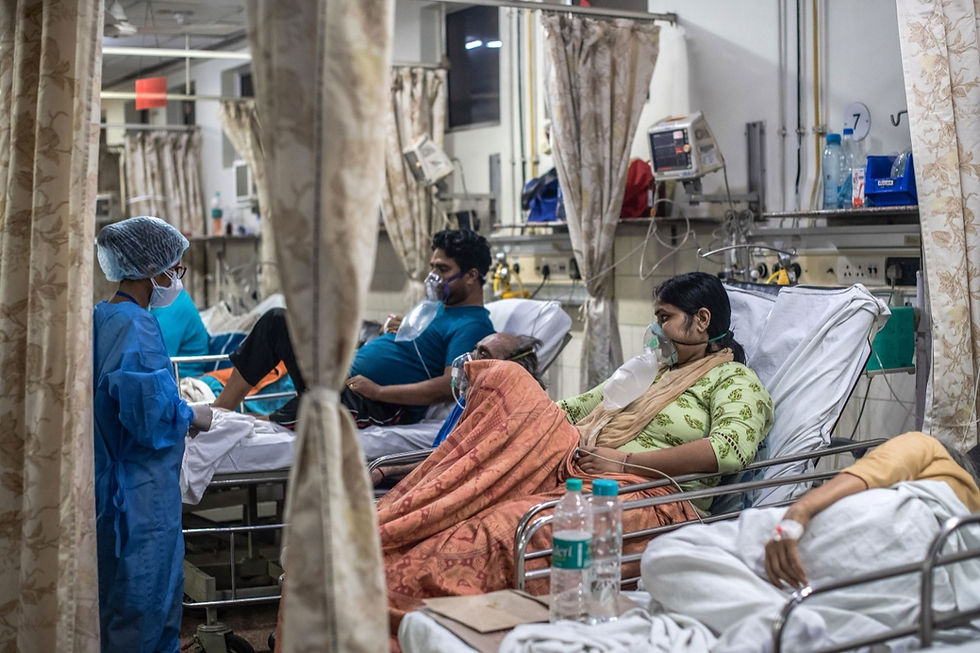The Worst Condition of Hospital Beds In India
- Abhishek

- May 22, 2021
- 6 min read
Updated: Sep 11, 2021
Introduction
The Covid 19 pandemic has propelled numerous examinations dependent on information about the illness and the reaction. Nonetheless, estimation in India is regularly feeble. There is a prerequisite for a more conspicuous alarm prior to using such data. In this article, we take a gander at one such issue: assessing medical care limits dependent on clinic beds.

The clinical benefits structure response to Covid 19 has been to expand the quantity of crisis center beds. Nevertheless, outrageous and fundamental thought patients in India may routinely require ventilators and ICU beds. There are no activities available about the number of ventilators or ICU beds, which clearly shows the worst condition of beds in India. Researchers have taken to the secret to addressing this opening. How sensible are these assessments?
Extrapolation from the check of emergency clinic beds
It's a good idea to utilize emergency clinic beds as a normalized proportion of the medical clinic limit. Foundation, gear, and labor guidelines for emergency clinics have been based on a for each bed premise. The quantity of medical caretakers, specialists, hardware, and even floor space is an element of the number of beds in the emergency clinic.
For instance, as indicated by the Indian government, a clinic ought to preferably have 80 to 85 sq m of plinth region per bed; there ought to be a latrine for every six beds; and one activity theater for every 50 beds in the overall ward. This makes surveying the availability of prosperous workplaces less difficult.

Check the number of clinical center beds in a country, and you have a sensation of the overall clinical benefits limit. Both the World Health Organization and the World Bank track the number of clinical facility beds per 1000 people as an extent of the clinical consideration limit.
Assessments
If we work inside such measurement of clinic limit dependent on the number of beds, what number of ventilators and ICU beds may be available in India?

The central government formed the IPH Standards in 2012, to improve the limit in government wellbeing administrations (run for the most part by the state governments). The principles for region clinics require 300 area emergency clinic beds per million populace.
IPH guidelines for region emergency clinics express that five to ten percent of the complete beds in a region emergency clinic ought to be ICU beds and every ICU bed ought to have a ventilator (among other gear).
On the off chance that the whole nation was to be up to IPHS principles, there ought to be 416,189 area emergency clinic beds and between 41,618 to 20,809 ventilators in the country (in the public authority framework).
In actuality, the numbers will most likely settle for the easiest option. Specialists have attempted to gauge the accessibility of clinic beds, ICUs, and ventilators for the current pandemic.
Scientists like, Rajagopalan and Choutagunta have surveyed the openness of crisis facility beds (both in government and private regions) in various Indian states. Singh et al. use a 2008 paper by Yeolekar and Mehta, which evaluates that there are around 5-8% ICU beds in government clinical facilities.
Singh et al. expect that around half of the ICU beds have a ventilator. This gives them a scope of 35,699 to 57,119 ventilators for the whole country (in the public authority framework). Likewise, Kapoor et al. gauge that there ought to be around 35,699 ICU beds and 17,850 ventilators for the country.
For U.P., they gauge 3,813 ICU beds and 1,907 ventilators.
The ground reality in Uttar Pradesh
How do the public authority yearnings and master gauges stack facing the ground reality?
In 2019, India's incomparable review foundation (the CAG), did an exhibition review of Hospital Management in Uttar Pradesh. U.P. has 75 locales and 174 region clinics (in 2018). The CAG covered seven regions (out of 75) for its survey of 16 government facilities. Likewise, three out of 11 local clinical facilities of Lucknow were examined. The seven areas which were totally covered by the audit (for region facilities) are dispersed across the five administrative districts of U.P. The CAG found that the fact of the matter was far away from the longing or measures.
The seven regions have a populace of 25.9 million. According to IPH guidelines, they ought to have 7,700 area clinic beds. The CAG discovered 2,275 beds, a deficit of more than 70%. On the off chance that the areas adhere to IPH guidelines, there ought to be 385 to 770 ICU beds for the ideal 7,700 locale medical clinic beds.
Whether or not IPH standards were kept up on a base of 2,275 beds, there should have been 113 to 228 ICU beds in the analyzed district crisis facilities. The CAG found that ' 10 out of the 11 area emergency clinics had no ICU beds. Just the Gorakhpur region emergency clinic had 13 ICU beds (3% of its absolute beds). To put it, of the seven locales investigated by the CAG, there were 13 ICU beds, all arranged in one region.
Indeed, even where there were ICU beds, the CAG discovered deficiencies of hardware considered fundamental for an ICU bed (according to IPH principles).
The CAG noted :
"review saw that solitary six High-end Monitors were accessible against the necessity of 14, seven Infusion siphons were accessible against the prerequisite of 14, while Ventilators, Ultrasound for obtrusive methodology and Arterial Blood Gas (ABG) investigation machine were not accessible at all in D.H. Lucknow. Essentially, in D.H. Gorakhpur, there were no Ventilators, Infusion Pumps, Ultrasound for obtrusive strategies, and ABG investigation machine."
In the seven locales where the CAG analyzed region crisis facilities, the CAG found no ventilators. In reality, even in the district, clinical facilities in Lucknow (outside the seven regions), 2% of the beds were ICU, and there were no ventilators.
The CAG report just covers seven locales out of U.P's. 75 areas. U.P. is perhaps the most unfortunate state. The public authority of U.P. additionally works some super-forte clinics where offices may be better, yet they will be not many. These seven areas establish 11% of U.P's. populace.
While the discoveries may not be illustrative of India, they are not irrelevant. The hole between focal government principles, master assessments, and the truth is tremendous.
Goodhart's law
For what reason is there a huge disparity between the IPH principles, master gauges and the truth saw by the CAG?
We may guess that Goodhart's Law is grinding away. Goodhart's law states: "When an action turns into an objective, it stops to be a decent measure".
For a long time, scholastic and strategy writing, in India, has stressed one measurement: the number of beds accessible in government emergency clinics. Press articles consistently censure the public authority for India's low bed to populace proportion. A path of least resistance for lawmakers and authorities is to glance acceptable in such estimation while holding back on different components of medical care.
Between 2014-2018 the Central Government spent Rupees 8.5 billion for the country out of which Rupees 1.5 billion was spent in U.P., under the National Health Mission, to update offices in state government emergency clinics. The outcome was a quick development in the number of beds (the action which wellbeing strategy creators are delicate to), and very little else.
Conclusion
This issue isn't restricted to emergency clinic beds. It reaches out to different pieces of the wellbeing area. The focal government works a point-by-point data set called the Health Management Information System. For instance, Smriti Sharma shows that there are critical errors in the data set. Numbers which depict the framework in helpless light are under-detailed while the numbers which show the wellbeing framework decidedly are expanded.
Utilizing the medical clinic bed measure to appraise the accessibility of medical services limit is deceiving.
In any event, when the public authority sets up new offices, estimation is being done based on new beds. Till April 11, the public authority had saved 100,000 clinic beds and 11,500 ICU beds in 586 medical clinics. On May 15, the Maharashtra government intended to save another 100,000 beds, simply in Mumbai with an extra 1,000 ICU beds. In considering the circumstance in medical care, this isn't sufficient data. We need to know the offices and workforce that will be accessible for these beds.

An overall way of thinking in India is to be cautious about utilizing information. Scientists need to acquire trust like the estimation interaction. This is especially basic where the organization which plays out a capacity is likewise the wellspring of information about a similar capacity. At the point when the fundamental information is feeble, no measure of cunning in insights can protect the contortion of our perspective on what is happening.






Comments